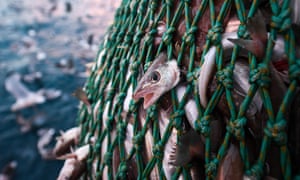https://www.theguardian.com/environment/2018/dec/20/marine-life-worse-off-inside-protected-areas-analysis-reveals
Marine life worse off inside 'protected' areas, analysis reveals
Findings expose ‘big lie’ behind European marine conservation, scientists say
Destructive trawling is more intense inside official marine sanctuaries, while endangered fish are more common outside them, a startling analysis of Europe’s seas has revealed.
It shows that far from conserving sealife, many legal marine protected areas (MPAs) are being damaged by industrial fishing. The work has exposed “the big lie” behind European marine conservation, experts say, with most MPAs completely open to trawling.
The researchers were able to assess the activity of fishing vessels in great detail thanks to satellite tracking equipment that is now compulsory on ships. They compared this with scientific data on the health of sea areas and looked at more than 700 MPAs, covering 16% of Europe’s territorial waters. In total, MPAs cover 29% of Europe’s waters.
This revealed that commercial trawling activity was on average almost 40% higher inside MPAs than in unprotected areas. Furthermore, endangered and critically endangered fish species such as sharks and rays were five times more abundant outside the MPAs.
“It should be the reverse,” said Prof Boris Worm, at Dalhousie University in Canada, who led the research. “When something is called a protected area, it actually needs to be protected. We know that when areas are actually protected they deliver: species recover, biodiversity increases and fisheries benefit as well, as fish become more abundant and spill outside these areas.
“One problem we have in the European Union is that while the conservation policies such as MPAs are a national matter, fisheries are managed by the EU as a whole. That disconnect may drive some of the problem we see here. One hand does not know what the other one is doing.”
On Wednesday, EU fisheries ministers once again set dozens of quotas that defied the scientific advice on fish stocks.
Prof Callum Roberts, at the University of York, UK, who was not part of the research, said: “This compelling study reveals the big lie behind European marine conservation. To be effective, all MPAs should be protected from trawling and dredging at a minimum, and many of them should prohibit all fishing.”
The study, published in the journal Science, found that 99% of the MPAs had no information on no-take zones in the authoritative World Database on Protected Areas and half had no management plan. Worm said Europe’s large MPAs did ban activities such as mining and dumping, “but the do not deal with the most prevalent industrial activity we have, which is bottom trawling.”
The work echoes a similar recent study on protected areas on land, which found that a third of all parks are under intense pressure. “But it is even worse in the oceans,” said Worm.
The reason for MPAs being worse at conserving marine life than unprotected areas may be because the MPAs cover those parts of the sea that are richest in fish, which are the same places that fishing vessels target with little if any restriction.
“If the MPAs were enforced they would be in the perfect place, because that is where all the fish are,” said Frédéric Le Manach, scientific director at the conservation group Bloom.
A UN target of 10% of the oceans becoming protected areas by 2020 is on target to be met. However, 90% of Europe’s MPAs are not classified according to criteria set by the International Union for the Conservation of Nature, the researchers found. “The IUCN guidelines say there cannot be any industrial use of protected areas but trawling is an industrial form of fishing” and occurs in 59% of Europe’s MPAs, said Worm.
The UK government published its latest report on MPAs on Monday, which said: “We have made substantial progress on the network as a whole since 2012 … there is, however, still work to be done, both in terms of the designation of sites and improved management of our waters.”
Ministers were considering introducing “highly protected marine areas”, it said. “In some MPAs, there may be a strong case for suspending all human activities to allow full recovery. [But] we must strike the right balance between achieving our conservation aims, whilst minimising the impact on sea users.”
A quarter of the UK’s waters are covered by 300 MPAs, but Roberts said just 1% of the area was protected from the most destructive fishing methods – bottom trawling and dredging, in which gear is dragged across the seabed.
“Most MPAs are no more than paper parks that offer no sanctuary at all to wildlife in the sea,” he said. “We have been fooling ourselves that there are cost-free protected areas where we can have it all.”

沒有留言:
張貼留言